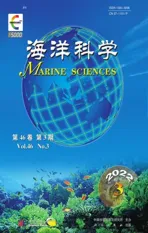东马努斯弧后盆地中酸性火山岩岩浆演化中的锂同位素特征
2022-04-14左丽薇
左丽薇, 黄 朋, 王 雄
东马努斯弧后盆地中酸性火山岩岩浆演化中的锂同位素特征
左丽薇1, 2, 黄 朋1, 王 雄1, 2
(1.中国科学院海洋研究所海洋地质与环境重点实验室, 山东 青岛 266071; 2.中国科学院大学, 北京 100049)
通过分析东马努斯海盆中酸性火山岩的全岩主量、微量元素以及锂同位素组成, 并结合前人数据, 讨论盆地岩浆体系的演化过程。分析数据显示, 东马努斯海盆主、微量元素与SiO2含量之间呈线性变化关系, 表明岩浆结晶分异过程控制东马努斯海盆岩浆演化过程。东马努斯弧后盆地火山岩富集流体相关元素, 指示东马努斯弧后盆地岩浆源区可能经历了俯冲流体的交代作用。在岩浆移出源区之后的演化阶段, 岩浆体系演化以结晶分异过程为主。锂同位素与流体示踪指数具相关性, δ7Li随俯冲流体加入呈现升高趋势, 而与岩浆结晶分异程度无相关性, 表明锂同位素分馏受控于流体交代作用。
东马努斯海盆; 中酸性火山岩; 演化过程; 锂同位素特征
西南太平洋马努斯海盆是一个快速扩张的弧后盆地, 岩浆作用强烈, 发育有从玄武岩到流纹岩的连续系列火山岩[1-4]。海盆产出的中酸性火山岩, 对于研究扩张环境下中酸性岩浆演化过程至关重要[4]。固体地球系统中, 中酸性岩浆的形成主要通过以下4种方式: 上地幔水饱和条件下的部分熔融[5-7]; 蚀变洋壳或蚀变辉长岩的部分熔融[8-9]; 分离结晶作用以及由基性镁铁质岩浆和高硅岩浆的混合作用产生[10-15]。马努斯弧后盆地构造环境复杂, 其岩浆成因, 特别是中酸性岩浆成因, 一直受到广泛关注[4, 16-18]。
马努斯弧后盆地作为洋底快速扩张中心, 同时受俯冲作用影响。锂作为非常活跃的流体活动性元素[19], 在俯冲带中可以作为各种地质作用的良好示踪剂。本文在前人研究的基础上, 依据东马努斯盆地火山岩锂元素与同位素组成, 以及其他相关元素分布特征, 初步探讨东马努斯火山岩的物质组分起源和演化过程。
1 地质背景
马努斯海盆位于西南太平洋俾斯麦海东部, 海盆北侧为不活动的马努斯海沟, 南侧为活动的新不列颠海沟, 其构造性质属于快速扩张的弧后盆地[1, 3, 17, 20-21]。海盆中部有一条近东西向展布的、被转换断层错断的伸展扩张带, 分布马努斯扩张转换带(Manus Extensional Transform Zone; ETZ)、马努斯扩张中心(Manus Spreading Center; MSC)、南部海脊(South Ridge; SR)和东南海脊(Southeast Ridge; SER)等构造单元[21-23]。
马努斯海盆可进一步划分为西、中和东马努斯盆地。本次研究区位于东马努斯盆地, 其构造性质上属于拉张裂谷, 产出从玄武岩到流纹岩的连续序列火山岩[1, 3, 20, 24](图1)。区内分布着PACMANUS、DESMOS和Susu Knolls等活跃热液区并发育广泛的多金属硫化物矿化作用[2, 20, 25-31]。
马努斯海盆基底年龄超过40 Ma, 记录了渐新世以来复杂的俯冲过程[24]。10 Ma以前, 海盆北部的太平洋板块沿马努斯海沟向南俯冲。大约在10 Ma, 新爱尔兰岛与翁通爪哇洋底高原碰撞造成俯冲方向倒转, 所罗门海板块开始沿新不列颠海沟向北俯冲[18]。所罗门板块年龄较为年轻(24~44 Ma), 岩石圈相对较热, 但可能包含较少的远洋沉积物。4 Ma以来, 俾斯麦海打开, 沿ETZ和MSC发生扩张[18, 21-22]。2~3 Ma以来, 马努斯盆地沿MSC进行了复杂扩张[24], 在海盆中形成Willaumez、Djaul、Weitin等左旋转换断层。0.78 Ma以后开始抬升并产生了海底扩张[16-18]。

图1 马努斯盆地地质背景图及岩石采样位置
注: 地质图根据[20, 25, 27]; 其中样品32和33-1采自PACMANUS热液区, 其他样品采自DESMOS热液区
2 样品和方法
文中使用的火山岩样品获取自“科学号”考察船201501航次。样品采集区域位于东马努斯海盆的PACMANUS及DESMOS热液区(图1), 样品相关信息见表1。

表1 样品编号和位置
样品手标本照片见图2, 均为致密块状火山岩, 黑色, 隐晶质结构, 岩石表面气孔构造发育良好。本文对样品进行了全岩主量、微量及锂同位素测试。虽然样品新鲜, 未发现海水蚀变迹象, 但在测试分析之前对样品进行了严格的预处理。挑选最新鲜的块状样品, 蒸馏水初步清洗, 去除表面黏附沉积物; 切割岩块, 去除表层可能发生风化、蚀变的部分; 取中心部分, 切割成小于0.1 cm的岩片, 再分别置于无水乙醇、稀盐酸中, 并水浴加热, 以去除有机物和沉积碳酸盐; 最后, 将岩片浸泡于超纯水中7 d, 每日超声清洗2次并更换超纯水, 以去除残留海水和试剂的影响。最后将样品烘干、研磨成粉末[27, 32]。
样品全岩主微量元素含量测试和锂同位素组成测试由北京核工业地质研究所的实验室完成。主量元素含量测试使用AB104L, Axios-mAX WDXFR, 方法依据国标GB/T 14506.28-2010[33], 烧矢量依据常规岩石矿物分析流程[29]。微量元素测试使用DRC-E ICP- MS, 方法依据国标GB/T 14506.30-2010[34]。
在锂同位素分析测试前, 要对样品进行溶解和分离提纯。首先据样品锂含量, 称取相应质量样品放置PFA消解罐中, 加入适量浓氢氟酸-浓硝酸(体积比3︰1)混合酸, 密封后于电热板加热24 h。打开消解罐, 蒸干后加入浓硝酸, 超声10 min, 再次蒸干, 重复2~3次, 直至白色沉淀变为棕黄色。再次加入浓硝酸, 加热12 h, 蒸干; 加入浓盐酸, 加热12 h至溶液澄清, 蒸干。最后加入盐酸溶解。将准备好的样品进行两次过柱, 使用干净Teflon烧杯收集淋洗液, 蒸干后冷却, 加入硝酸, 置于干净离心管中[35]。
锂同位素使用PlasmaⅡ MC-ICP-MS测试。以2%的硝酸为介质将分离纯化后的样品引入仪器, 使用2个法拉利杯分别收集6Li和7Li信号。锂仅有2个稳定同位素, 在测试中无法进行质量分馏的内部校正, 所以按照空白-标样-空白-标样-空白-标样流程进行测试[35]。测试结果表示为δ7Li=[(样品/标准)–1]×1 000‰, 其中样品为样品7Li和6Li的同位素丰度之比7Li/6Li,标准为样品相邻两次标样7Li/6Li的平均值, 采用的Li同位素标准为NIST-LSVEC, 测试精确度2SD<0.6‰。

图2 样品手标本照片
3 结果
3.1 主量元素特征
火山岩样品主量元素含量见表2。根据火山岩TAS分类(图3a), 样品34-1, 40-1, 40-2为玄武质安山岩, 样品32, 33-1为英安岩。所有样品均落入中钾钙碱性系列区域内(图3b)。样品SiO2的范围在54.32 wt.%~67.40 wt.%之间, MgO在6.03 wt.%~0.93 wt.%之间, K2O在0.65 wt.%~1.75 wt.%之间, TiO2均大于0.50 wt.%, 其中wt.%表示质量百分比。
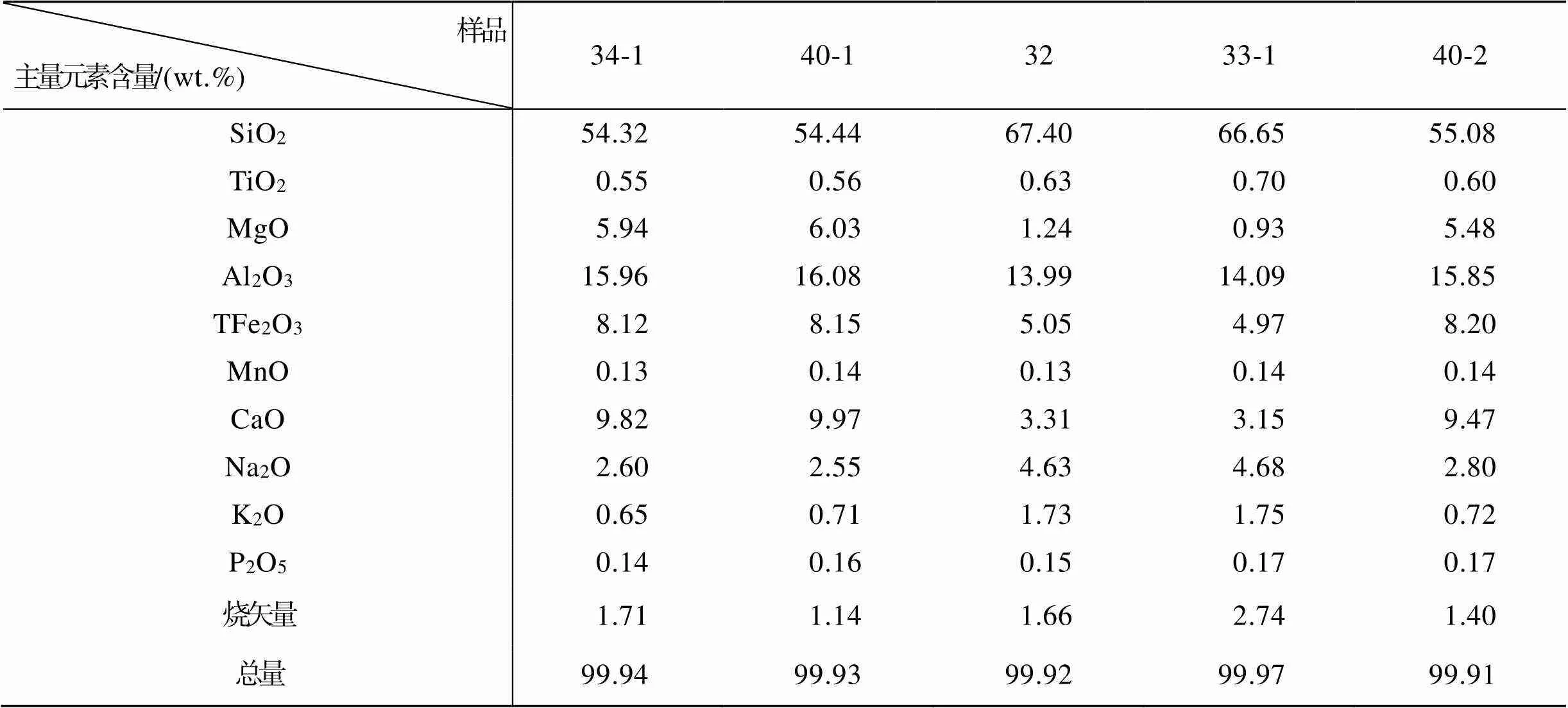
表2 东马努斯盆地火山岩主量元素含量

图3 东马努斯火山岩全碱图解和K2O vs.SiO2图解
注: 图a岩石类型边界根据[36]; 图b阴影带引自[37]。东马努斯海盆(eastern Manus Basin, EMB)数据引用自[4, 16-17, 38], 马努斯扩张中心(Manus spreading center, MSC)数据引自[4, 16], 此后同。
3.2 微量元素特征
火山岩样品微量元素含量见表3。样品稀土元素(REE)总含量处于37.25~90.55 μg·g–1之间。经球粒陨石标准化, 稀土元素分布模式显示明显的右倾特征, 即轻稀土元素相对重稀土元素富集(图4a)。样品原始地幔标准化蛛网图(图4b)显示, 亏损高场强元素(Th, Nb, Ta等), 而富集大离子亲石元素(Pb, K, Rb, Ba, U等), 显著区别于MSC的MORB, 具有典型的岛弧熔岩特征[4, 16-17, 38]。
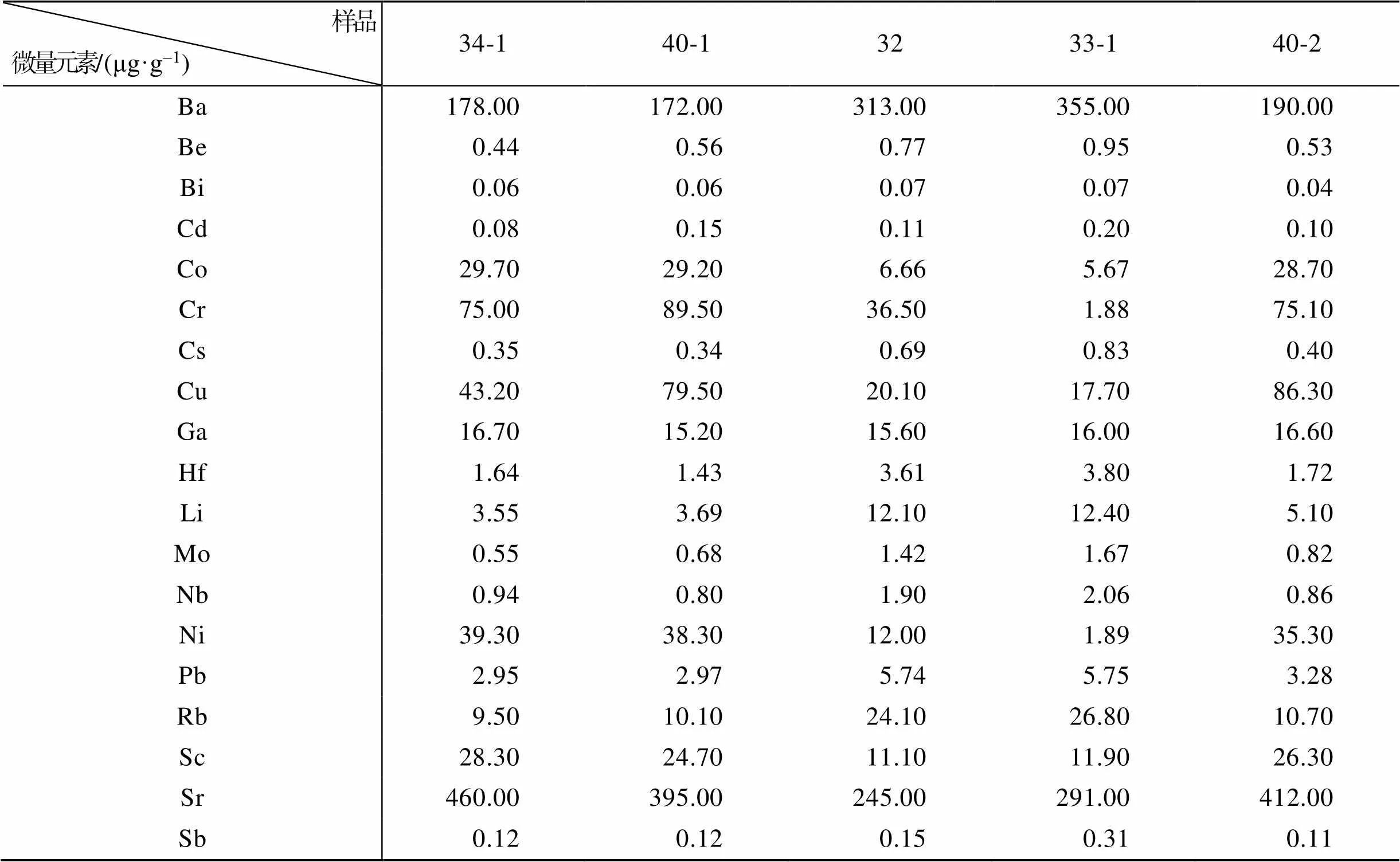
表3 东马努斯盆地火山岩微量元素含量
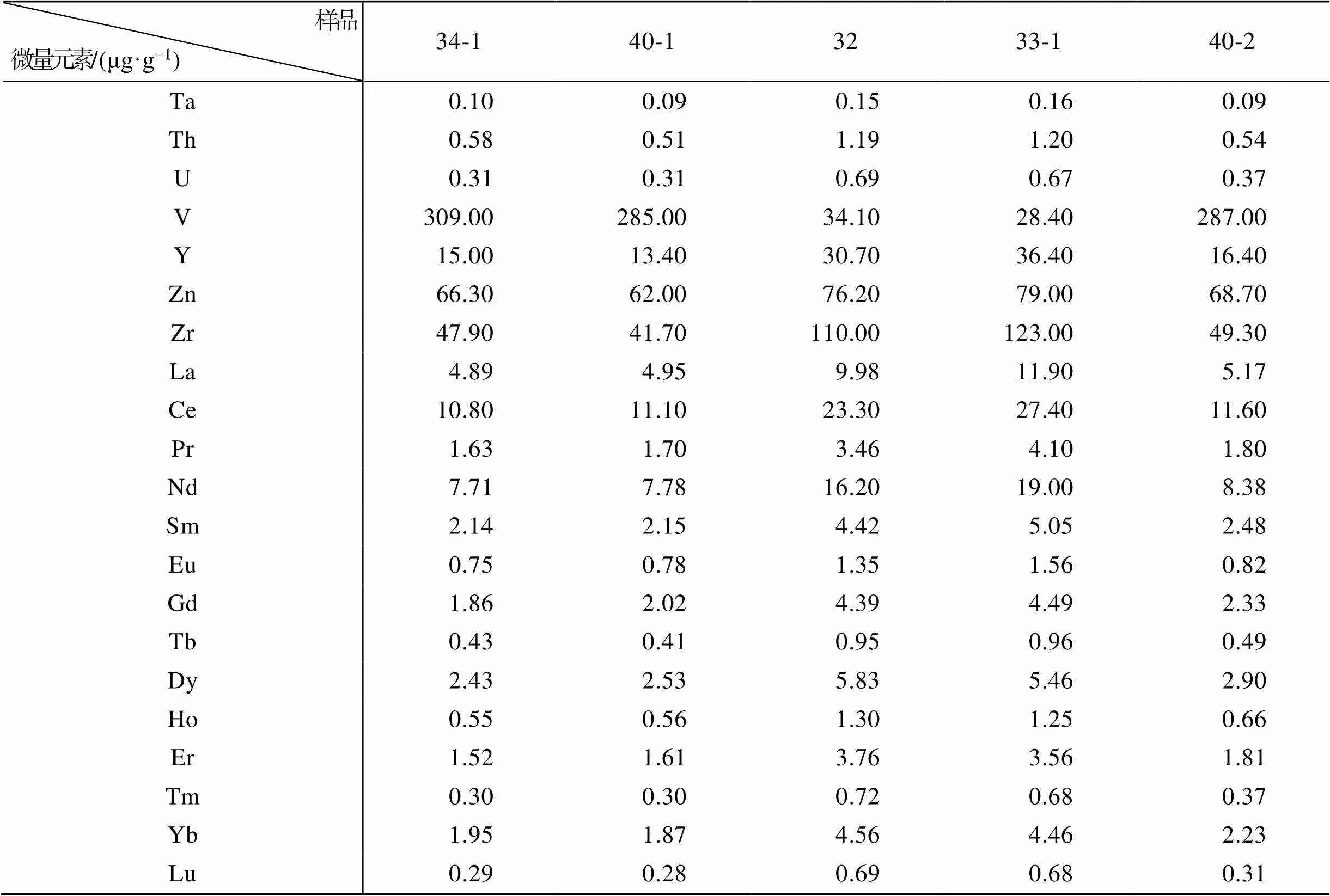
续表
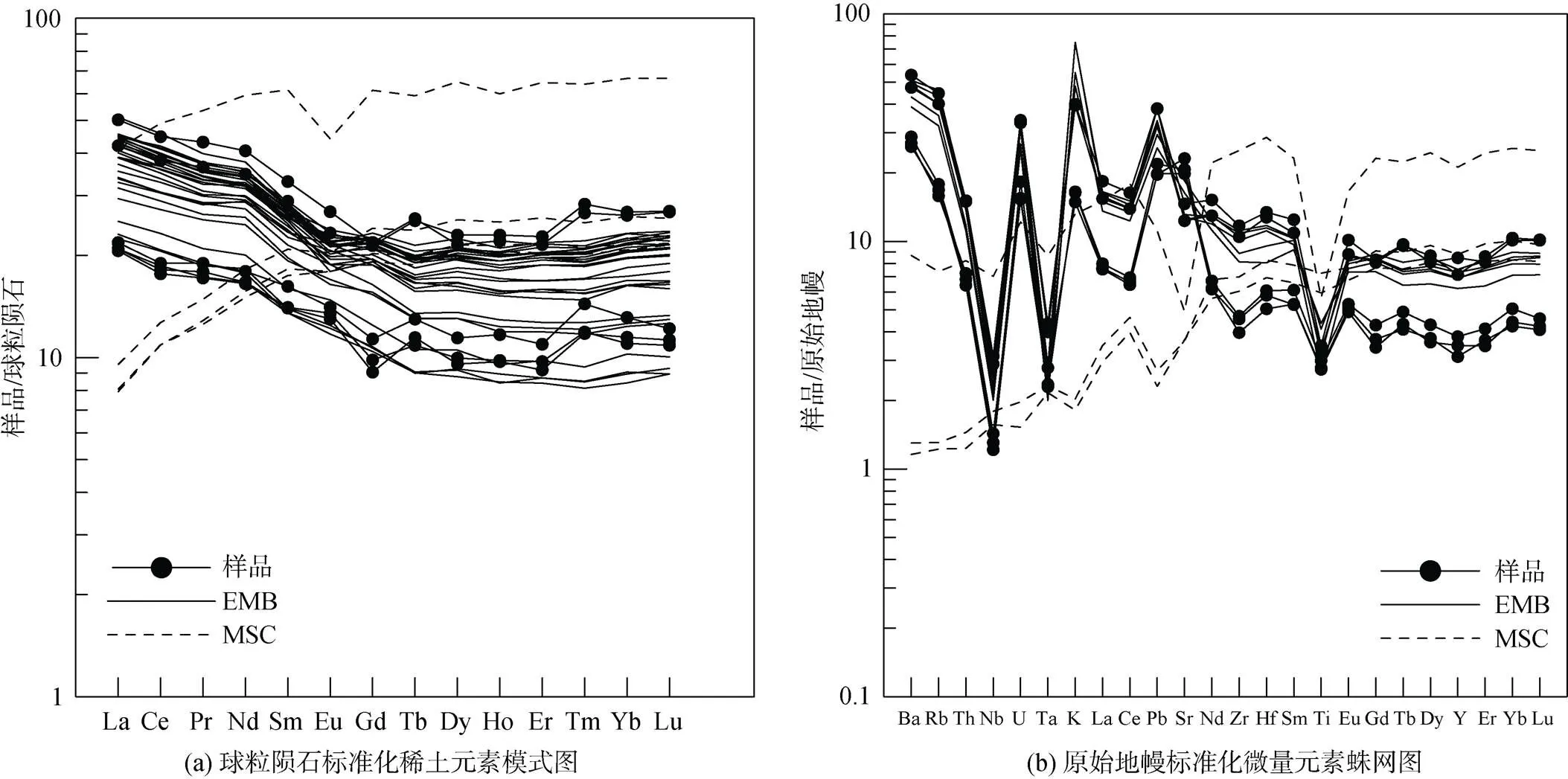
图4 马努斯火山岩球粒陨石标准化稀土元素模式图和原始地幔标准化微量元素蛛网图
注: 球粒陨石和原始地幔数据引自[39]。
3.3 锂元素和同位素特征
马努斯盆地火山岩Li含量见表3。样品Li含量在3.55~12.4 μg·g–1之间。其中玄武质安山岩(34-1, 40-1, 40-2)的Li含量在3.55~5.1 μg·g–1之间, 英安岩(32, 33-1)的Li含量在12.1~12.4 μg·g–1之间。样品Li同位素特征见表4。所有火山岩样品δ7Li在2.9‰~6.1‰之间变化, 2SD在0.03‰~0.56‰之间。Li属于中等不相容元素, 分配系数在0.25~ 0.35之间[19, 40], 因此随着岩浆分异作用, 火山岩的Li含量会升高。图5显示, 在马努斯弧后盆地岩浆岩中, 随着SiO2、Rb、Y含量的升高, 火山岩的Li含量升高; 随着MgO含量的升高, 火山岩的Li含量降低。

表4 东马努斯盆地火山岩Li同位素特征

图5 SiO2、MgO、 Rb、Y浓度分别对Li浓度作图
4 讨论
相对于玄武岩, 中酸性火山岩可能经历了更长、更复杂的演化过程。马努斯盆地作为俯冲环境下的弧后扩张中心, 对于研究扩张环境内中酸性火山岩演化具有重要意义。Li为不相容元素, 并易富集于富水流体内; 此外, Li元素包含6Li和7Li两种稳定同位素, 其相对质量差达17%。因此, Li元素及稳定同位素组成可以很好地示踪马努斯盆地岩浆演化过程。
4.1 俯冲组分识别
根据微量元素蛛网图(图4b)可知, 马努斯盆地火山岩大离子亲石元素(large ion lithophile element, LILE: K, Rb, Ba)及流体活动性元素(fluid mobile element, FME: U, Pb)富集, 高场强元素(high field strength element, HFSE: Nb, Ta, Ti)亏损, 具有岛弧熔岩的典型特征[41]。根据图6的锂元素及同位素特征, 马努斯弧后盆地火山岩主要落入岛弧火山岩范围。样品的Nd/Pb(~3)比值远低于典型MORB(亏损)地幔(~24)所代表的地幔, 表明样品中Pb组成明显受俯冲组分影响。此外, Sr/Nd(15.12~59.66)和Ba/La(29.83~ 36.75)比值明显高于N-MORB(Sr/Nd: 12.32; Ba/La: 2.52[39]), 表明盆地岩浆体系明显受俯冲流体影响, 大量Sr、Ba进入到岩浆源区。

图6 δ7Li vs.(Li–1)/10–6图解(图修改自[42])
俯冲物质通过俯冲熔体或/和流体向岛弧之下岩浆源区运移。但实验结果表明, 在典型的俯冲区域, 古老的俯冲板片组分不会熔融, 因为温度太低; 只有年轻的、热的岩石圈俯冲时, 熔融才是一个可行的过程[43]。而俯冲流体可以来自于俯冲岩石圈和上覆沉积物含水矿物的分解。随着深度增加, 环境温度-压力升高, 流体溶解度增高而元素与残余矿物结合力降低, 流体和板片岩石的反应可以造成FME和LILE的有选择富集于流体相[40]。
Ba/La-Th/Yb可以用来指示板片流体或沉积物熔体的输入状况。熔岩的高Ba/La值代表板片来源流体的加入, 而高Th/Yb代表了沉积物或沉积物熔体的加入[44]。马努斯火山岩Ba/La比高于MORB, 表明了板片来源流体的影响; 而采自MSC的玄武岩与MORB值相似(图7实心菱形图标所示), 表明受俯冲组分影响较小或不受其影响。本次分析样品在图中位置与新不列颠弧受到俯冲流体影响的岛弧熔岩相近, 也印证了马努斯弧后火山岩受俯冲流体影响。
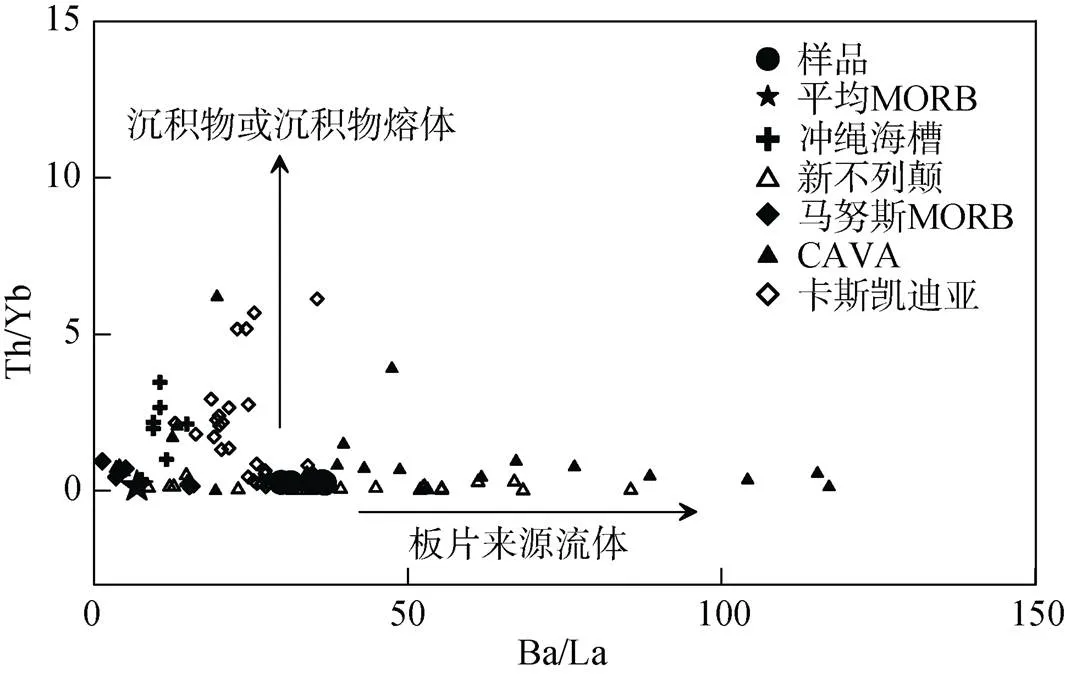
图7 Th/Yb vs.Ba/La图解(图参照[44], 数据引自[40, 45-48])
锂同位素组成与流体活动指标间具有一定相关性(图8)。Ba在流体和熔体中均为活动性元素。而Nb相对稳定, 不受流体和熔体活动影响。Th仅优先富集于熔体。Ba/Nb值指示俯冲物质的输入; Th/Nb指示俯冲熔体输入; 相应地, Ba/Th指示俯冲流体的输入。随着δ7Li增加, Ba/Nb和Ba/Th呈现增加趋势, 而Th/Nb保持稳定, 表明俯冲流体的输入影响马努斯弧后火山岩锂同位素组成。但经受俯冲流体交代的东马努斯火成岩, 其锂同位素组成与大洋中脊玄武岩(1.5‰~5.6‰)相近(图6)。在前人相关研究中, 也存在上述现象。其原因在于锂离子与镁、铁离子半径相似, 可优先置换进入镁铁质硅酸盐。在俯冲脱水过程中, Li大量保留于俯冲板片中, 并被运移至地球深部, 并未释放到弧下熔融区; 或是在流体向熔融区域运移的过程中, 与地幔反应, Li优先进入地幔橄榄岩中, 仅有少量Li到达弧下熔融区[49]。

图8 流体示踪指数vs.δ7Li图解
Tomascak等[50]研究发现, 由于锂与镁硅酸盐的相容性, 板片流体和地幔橄榄岩反应会使得流体B/Li升高, 大部分板片来源的重锂同位素组分优先保留在地幔中, 岛弧火山岩的δ7Li类似MORB, 并且跨越岛弧没有系统性变化。全球大洋中脊玄武岩研究显示, 上地幔包含大量锂, 其同位素组成较为均一[51]。因此, 无论是何种地质过程产生的上地幔熔体, 都具有与其他幔源熔体相似的锂同位素特征。大多数俯冲相关熔岩具有与MORB或OIB相似的δ7Li值, 支持上述观点。这一方面表明其岩浆的幔源成因, 另一方面也指示了源自俯冲板片的物质不足够富集Li, 或者δ7Li未发生显著分馏, 从而明显改变锂同位素特征。
Halama等[52]对勘察加岛弧的弧下地幔研究显示尽管存在来自板片物质的交代作用, 弧下地幔和MORB地幔仍然具有相似的δ7Li值。勘察加岛弧捕虏体研究也发现, 尽管岩石学证据表明存在流体交代作用, 但没有证据显示流体显著影响了弧下浅部橄榄岩地幔的锂元素及同位素, 其δ7Li值与MORB相似[53]。进一步研究表明, Li在板片流体释放时分馏, 但不会导致大量Li移出板片[54], 纯粹的固/流体过程导致深俯冲板块δ7Li下降不超过3‰[55]。
因此, 在马努斯弧后盆地岩浆演化过程中, 尽管流体活动性元素显示其岩浆源区受到俯冲板片流体的影响, 但锂同位素并未在流体交代过程中显著增加。
4.2 结晶分异作用
结晶分异作用是岩浆体系最可能经历的地质过程。封闭体系条件下, 结晶分异作用的进行会对岩浆物质组成产生特定影响, 可通过火山岩元素和同位素组成的变化趋势, 确定岩浆体系所经历的地质过程。
哈克图解(图9)显示, 马努斯盆地火山岩Al2O3、TiO2、P2O5的含量随SiO2含量增加先呈现增加趋势, 后呈现降低趋势(图9a, g, h), 表明斜长石、钛铁矿和磷灰石发生明显结晶分异; 而CaO、Fe2O3和MgO的含量随SiO2含量增加而减少(图9b, c, e), 则指示橄榄石、辉石发生结晶分异。上述主量元素含量变化趋势, 与封闭体系内岩浆结晶分异作用所引起的岩浆组成变化相一致。
据前人研究显示, 影响锂同位素平衡分馏的关键因素是温度。在低温条件下, 岩石和流体体系内锂同位素分馏强烈[56]; 温度高于350 ℃时, 锂同位素分馏较弱[51]; 而在大于1 050 ℃的高温岩浆分异过程中, 几乎不显示锂同位素分馏[57-58]。
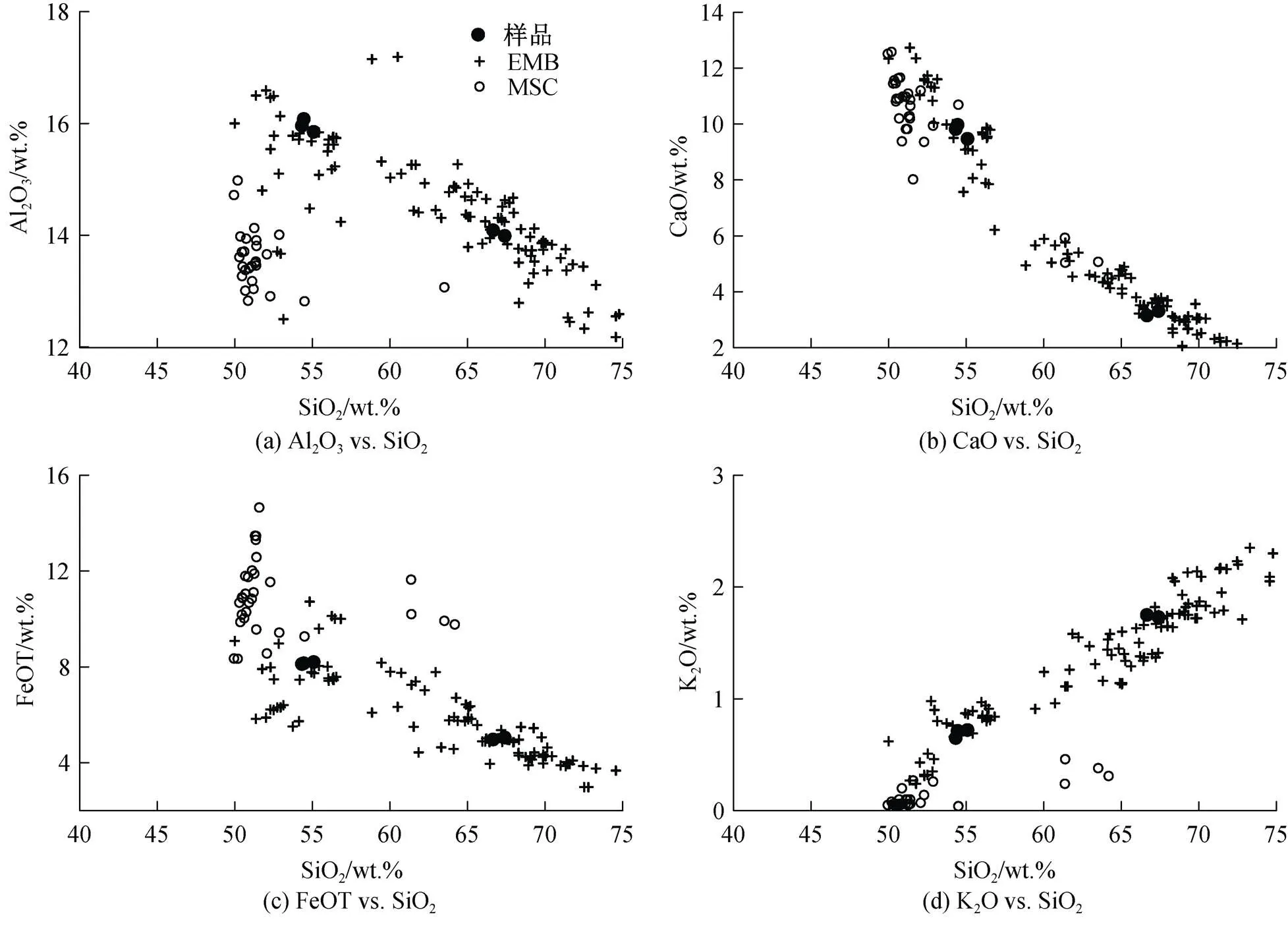
锂同位素平衡分馏是由于键能的差异导致6Li和7Li在不同相之间的分配不同。7Li倾向于进入键能高的位置中。键能与配位数有关, 低配位数位置具有高键能。Li在硅酸盐矿物中主要以6次配位的形式存在, 而在熔体中大约以4.5次配位的形式存在。因此在岩浆结晶分异过程中,6Li应优先进入早期结晶的矿物相中, 而7Li会倾向于富集在残余熔体当中[54, 56, 59-60]。所以在岩浆分异后期结晶的矿物中应富集7Li, δ7Li随着岩浆分异程度的增加而增加。对于东马努斯弧后盆地火山岩, 随着SiO2含量的升高, δ7Li呈现降低趋势; 随着MgO含量升高, δ7Li呈现升高趋势(图10)。这说明锂同位素的分馏不是受岩浆分异作用所控制。这与前人关于锂同位素分馏机制的研究结果相吻合[50, 56, 58, 61-62]。

图10 SiO2, MgO vs.δ7Li
5 结论
根据所获取的火山岩元素、锂稳定同位素组成特征, 可以确定采自马努斯海盆的岩石样品归属中钾钙碱性系列, 岩性为玄武质安山岩和英安岩。区内岩浆保持幔源岩浆特征, 岩浆演化过程主要受结晶分异作用的控制, 并且在岩浆源区有俯冲流体的加入。马努斯弧后盆地火山岩的锂同位素分馏不受岩浆结晶分异影响, 而受控于俯冲流体交代作用。
[1] MOSS R, SCOTT S D.Geochemistry and mineralogy gold-rich hydrothermal precipitates from the eastern Manus basin, Papua New Guinea[J].The Canadian Mineralogist, 2001, 39(4): 957-978.
[2] ORTEGA-OSORIO A, SCOTT S D.Morphological and chemical characterization of neutrally buoyant plume- derived particles at the eastern Manus basin hydrothermal field, Papua New Guinea[J].Canadian Mineralogist, 2001, 39: 17-31.
[3] YANG K, SCOTT S D.Magmatic degassing of volatiles and ore metals into a hydrothermal system on the modern sea floor of the eastern Manus back-arc basin, western Pacific[J].Economic Geology, 2002, 97(5): 1079-1100.
[4] SINTON J M, FORD L L, CHAPPELL B, et al.Magma genesis and mantle heterogeneity in the Manus back- arc basin, Papua New Guinea[J].Journal of Petrology, 2003, 44(1): 159-195.
[5] KAWAMOTO T.Melting temperature and partial melt chemistry of H2O-saturated mantle peridotite to 11 Gigapascals[J].Science, 1997, 276(5310): 240-243.
[6] CARMICHAEL I S.The andesite aqueduct: perspectives on the evolution of intermediate magmatism in west-central (105-99°W) Mexico[J].Contributions to Mineralogy and Petrology, 2002, 143: 641-663.
[7] GROVE T, TILL C, KRAWCZYNSKI M J.The role of H2O in subduction zone magmatism[J].Annual Review of Earth and Planetary Sciences, 2012, 40: 413-439.
[8] COOGAN L A, Mitchell N C, O’Hara M J.Roof assimilation at fast spreading ridges: An investigation combining geophysical, geochemical, and field evidence[J].Journal of Geophysical Research Solid Earth, 2003, 108: 1-14.
[9] KOEPKE, BERNDT J, FEIG S, et al.The formation of SiO2-rich melts within the deep oceanic crust by hydrous partial melting of gabbros[J].Contributions to Mineralogy and Petrology, 2007, 153: 67-84.
[10] GILL J B.Orogenic andesites and plate tectonics[M].New York: Springer, 1981.
[11] LE ROUX P J, SHIREY S B, HAURI E H, et al.The effects of variable sources, processes and contaminants on the composition of northern EPR MORB (8–10 °N and 12–14 °N): evidence from volatiles (H2O, CO2, S) and halogens (F, Cl)[J].Earth and Planetary Science Letters, 2006, 25: 209-231.
[12] JAGOYTZ O, BURG J P, HUSSAIN S, et al.Construction of the granitoid crust of an island arc part I: geochronological and geochemical constraints from the plutonic Kohistan (NW Pakistan)[J].Contributions to Mineralogy and Petrology, 2009, 158: 739-755.
[13] DESSIMOZ M, MÜNTERNER O and ULMER P.A case for hornblende dominated fractionation of arc magmas: the Chelan complex (Washington Cascades)[J].Contributions to Mineralogy and Petrology, 2012, 163: 567-589.
[14] HILDRETH W, MOORBATH S.Crustal contributions to arc magmatism in the Andes of central Chile[J].Contributions to Mineralogy and Petrology, 1988, 98: 455-489.
[15] DUNGAN M, DAVIDSON J.Partial assimilative recycling of the mafic plutonic roots of arc volcanoes: an example from the Chilean Andes[J].Geology, 2004, 32: 773-776.
[16] BEIER C, BACH W, TURNER S, et al.Origin of silicic magmas at spreading centres‒an example from the south east rift, Manus basin[J].Journal of Petrology, 2015, 56(2): 255-272.
[17] PARK S H, LEE S M, KAMENOV G D, et al.Tracing the origin of subduction components beneath the south east rift in the Manus basin, Papua New Guinea[J].Chemical Geology, 2010, 269(3/4): 339-349.
[18] BEIER C, TURNER S P, SINTON J M, et al.Influence of subducted components on back-arc melting dynamics in the Manus basin[J].Geochemistry Geophysics Geosystems, 2010, 11: Q0AC03.doi.org/10.1029/2010GC003037.
[19] RYAN J G, LANGMUIR C H.The systematics of lithium abundances in young volcanic-rocks[J].Geochimica Et Cosmochimica Acta, 1987, 51(6): 1727-1741.
[20] BINNS R A, SCOTT S D.Actively forming polymetallic sulfide deposits associated with felsic volcanic rocks in the eastern Manus back-arc basin, Papua New Guinea[J].Economic Geology, 1993, 88(8): 2226-2236.
[21] MARTINEZ F, TAYLOR B.Backarc spreading, rifting, and microplate rotation, between transform faults in the Manus basin[J].Marine Geophysical Research, 1996, 18(2/4): 203-224.
[22] TAYLOR B.Bismarck Sea: Evolution of a back-arc basin[J].Geology, 1979, 7(4): 171-174.
[23] BEAUDOIN Y, SCOTT S D.Pb in the PACMANUS sea-floor hydeothermal system, eastern Manus basin: numerical modeling of a magmatic versus leached origin[J].Economic Geology, 2009, 104(5): 749-758.
[24] KAMENETSKY V S, BINNS R A, GEMMELL J B, et al.Parental basaltic melts and fluids in eastern Manus backarc basin: implications for hydrothermal mineralisation[J].Earth and Planetary Science Letters, 2001, 184(3): 685-702.
[25] 马瑶.东马努斯弧后盆地岩浆岩地球化学特征及其对热液活动中Cu的物质供给研究[D].青岛: 中国科学院研究生院(中国科学院海洋研究所), 2016.
MA Yao.Geochemistry of igneous rocks and material contribution of Cu to seafloor hydrothermal system in eastern Manus basin[D].Qingdao: The University of Chinese Academy of Sciences(The Institute of Oceanology, Chinese Academy of Sciences), 2016.
[26] 马瑶, 殷学博, 王晓媛等.构造-岩浆作用对热液活动的控制机理: 马努斯海盆为例[J].海洋科学, 2018, 42(5): 163-171.
MA Yao, YIN Xuebo, WANG Xiaoyuan et al.Influence of tectonic-magmatism on hydrothermal activity: a case study of the Manus basin[J].Marine Sciences, 2018, 42(5): 163-171.
[27] 赵霞, 黄朋, 胡宁静等.东马努斯盆地高镁安山岩物质来源及演化过程——基于全岩主微量和同位素分析[J].海洋与湖沼, 2017, 48(1): 8-21.
ZHAO Xia, HUANG Peng, HU Ningjing et al.Magma source and evolution of high-Mg andesite from eastern Manus basin-geochemical and istopic constrains[J].Oceanologia et Limnologia Sinica, 2017, 48(1): 8-21.
[28] 赵霞, 黄朋, 胡宁静等.东马努斯盆地热液蚀变火山岩元素迁移特征及影响因素[J].海洋地质与第四纪地质, 2017, 37(3): 86-101.
ZHAO Xia, HUANG Peng, HU Ningjing, et al.Gharacteristics and influence factors of element migration of hydrothermal altered rock in eastern Manus basin[J].Marine Geology and Quaternary Geology, 2017, 37(3): 86-101.
[29] 赵霞.东马努斯盆地普通火山岩、高镁安山岩及蚀变岩石地球化学特征研究[D].青岛: 中国科学院大学(中国科学院海洋研究所), 2017.
ZHAO Xia.The study of geochemical characteristics of general volcanic rocks, high-Mg andesite and altered rock in eastern Manus basin[D].Qingdao: The University of Chinese Academy of Sciences (The Institute of Oceanology, Chinese Academy of Sciences), 2017.
[30] 曾志刚, 陈帅, 王晓媛, 等.东马努斯海盆PACMANUS热液区Si-Fe-Mn羟基氧化物的矿物学和微形貌特征[J].中国科学: 地球科学, 2013, 43(1): 61-71.
ZENG Zhigang, CHEN Shuai, WANG Xiaoyuan, et al.Mineralogical and micromorphological characteristics of Si-Fe-Mn oxyhydroxides from the PACMANUS hydrothermal field, eastern Manus basin[J].Science China: Earth Sciences, 2013, 43(1): 61-71.
[31] 杨宝菊.东马努斯海盆PACMANUS热液区Si-Fe- Mn氧化物的形成机制及其对热液活动的指示[D].青岛: 中国科学院研究生院(中国科学院海洋研究所), 2015.
YANG Baoju.The forming mechanism of Si-Fe-Mn oxides and implications for hydrothermal activity at the PACMANUS hydrothermal field, eastern Manus basin[D].Qingdao: The University of Chinese Academy of Sciences (The Institute of Oceanology, Chinese Academy of Sciences), 2015.
[32] 黄朋.冲绳海槽火山活动及其构造意义[D].青岛: 中国科学院研究生院(中国科学院海洋研究所), 2005.
HUANG Peng.The volcanic activities and their implications in the Okinawa trough[D].Qingdao: The University of Chinese Academy of Sciences (The Institute of Oceanology, Chinese Academy of Sciences), 2005.
[33] 中华人民共和国国家质量监督检验检疫总局, 中国国家标准化管理委员会.硅酸盐岩石化学分析方法第28部分: 16个主次成分量测定 GB/T 14506.28—2010[S].北京: 中国标准出版社, [2010-11-10].
General Administration of Quality Supervision, Inspection and Quarantine of the People’s Republic of China, the China National Standardization Management Committee.Methods for chemical analysis of silicate rocks — Part 28: Determination of 16 major and minor elements content GB/T 14506.28—2010[S].Beijing: Standards Press of China, [2010-11-10].
[34] 中华人民共和国国家质量监督检验检疫总局, 中国国家标准化管理委员会.硅酸盐岩石化学分析方法第30部分: 44个元素量测定 GB/T 14506.30-2010[S].北京: 中国标准出版社, [2010-11-10].
General Administration of Quality Supervision, Inspection and Quarantine of the People’s Republic of China, the China National Standardization Management Committee.Methods for chemical analysis of silicate rocks - Part 30: Determination of 44 elements GB/T 14506.30-2010[S].Beijing: Standards Press of China, [2010-11-10].
[35] 张俊文, 孟俊伦, 赵志琦, 等.多接收电感耦合等离子质谱法准确测定天然地质样品中的锂同位素组成[J].分析化学, 2019, 47(3): 415-422.
ZHANG Junwen, MENG Junlun, ZHAO Zhiqi, et al.Accurate determination of lithium isotopic compositions in geological samples by multi-collector inductively coupled plasmon-mass spectrometry[J].Chinese Journal of Analytical Chemistry, 2019, 47(3): 415-422.
[36] LE MAITRE R W, BATEMAN P, DUDEK A, et al.A classification of igneous rocks and glossary of terms: recommendations of the international union of geological sciences subcommission on the systematic of igneous rocks[M].Blackwell, Oxford, 1989: 193.
[37] RICKWOOD P C.Boundary lines within petrologic diagrams which use oxides of major and minor elements[J].Lithos, 1989, 22: 247-263.
[38] SUN W, BINNS R, FAN A C, et al.Chlorine in submarine volcanic glasses from the eastern Manus basin[J].Geochimica et Cosmochimica Acta, 2007, 71(6): 1542- 1552.
[39] SUN S S, MCDONOUGH W F.Chemical and isotopic systematics of oceanic basalts: Implications for mantle composition and processes[J].Geological Society London Special Publications, 1989, 42: 313-345.
[40] CHAN L H, LEEMAN W P, YOU C F.Lithium isotopic composition of central American volcanic arc lavas: Implications for modification of subare mantle by slab-derived fluids[J].Chemical Geology, 1999, 160(4): 255-280.
[41] WOODHEAD J D, JOHNSON R W.Isotopic and trace- element profiles across the new Britain island arc, Papua New Guinea[J].Contributions to Mineralogy and Petrology, 1993, 113(4): 479-491.
[42] 汤艳杰, 张宏福, 英基丰.地幔中EM1端员成因的锂同位素制约[J].矿物岩石地球化学通报, 2011, 30(1): 13-19.
TANG Yanjie, ZHANG Hongfu, YING Jifeng.Sr-Nd-Li isotopic constraints on the origin of EM1 end-member[J].Bulletin of Mineralogy, Petrology and Geochemistry, 2011, 30(1): 13-19.
[43] PEACOCK S M, RUSHMER T, THOMPSON A B.Partial melting of subducting oceanic crust[J].Earth and Planetary Science Letters, 1994, 121: 227-244.
[44] WOODHEAD J D, HERGT J M, DAVIDSON J P, et al.Hafnium isotope evidence for ‘conservative’ element mobility during subduction processes[J].Earth and Planetary Science Letters, 2001, 192(3): 331-346.
[45] WOODHEAD J D, EGGINS S M, JOHNSON R W.Magma genesis in the new Britain island arc: further insights into melting and mass transfer processes[J].Journal of Petrology, 1998, 39(9): 1641-1668.
[46] MAGNA T, WIECHERT U, GROVE T L, et al.Lithium isotope fractionation in the southern Cascadia subduction zone[J].Earth and Planetary Science Letters, 2006, 250(3/4): 428-443.
[47] AREVALO R and MCDONOUGH W F.Chemical variations and regional diversity observed in MORB[J].Chemical Geology, 2001, 271(1/2): 70-85.
[48] GUO K, ZHAI S, YU Z, et al.Geochemical and Sr-Nd- Pb-Li isotopic characteristics of volcanic rocks from the Okinawa trough: Implications for the influence of subduction components and the contamination of crustal materials[J].Journal of Marine Systems, 2018, 180: 140-151.
[49] MORIGUTI T, SHIBATA T, NAKAMURA E.Lithium, boron and lead isotope and trace element systematic of Quaternary basaltic volcanic rocks in northeastern Japan: mineralogical controls on slab-derived fluid composition[J].Chemical Geology, 2004, 212(1/2): 81-100.
[50] TOMASCAK, PAUL B, RYAN, et al.Lithium isotope evidence for light element decoupling in the Panama subarc mantle[J].Geology, 2000, 28(6): 507-510.
[51] TOMASCAK P B, LANGMUIR C H, ROUX P, et al.Lithium isotopes in global mid-ocean ridge basalts[J].Geochemica et Cosmochimica Acta, 2008, 72(6): 1626- 1637.
[52] HALAMA R, SAVOV I P, RUDNICK R L, et al.Insights into Li and Li isotope cycling and sub-arc metasomatism from veined mantle xenoliths, Kamchatka[J].Contributions to Mineralogy & Petrology, 2009, 158(2): 197-222.
[53] IONOV D A, SEITZ H M.Lithium abundances and isotopic compositions in mantle xenoliths from subduction and intra-plate settings: mantle sources vs.eruption histories[J].Earth & Planetary Science Letters, 2008, 266(3/4): 316-331.
[54] WUNDER B, MEIXNER A, ROMER R L, et al.Temperature-dependent isotopic fractionation of lithium between clinopyroxene and high-pressure hydrous fluids[J].Contributions to Mineralogy & Petrology, 2006, 151(1): 112-120.
[55] MARSCHALL H R, STRANDMANN P, SEITZ H M, et al.The lithium isotopic composition of orogenic eclogites and deep subducted slabs[J].Earth & Planetary Science Letters, 2007, 262(3/4): 563-580.
[56] 刘海洋.俯冲变质作用与岩浆过程中的锂同位素地球化学[D].合肥: 中国科学技术大学, 2018.
LIU Haiyang.Lithium isotope geochemistry in subduction zone metamorphism and magmatic process[D].Hefei: University of Science and Technology of China, 2018.
[57] TOMASCAK P B, TERA F, HELZ R T, et al.The absence of lithium isotope fractionation during basalt differentiation: new measurements by multicollector sector ICP-MS[J].Geochimica et Cosmochimica Acta, 1999, 63(6): 907-910.
[58] CHAN L H, FREY F A.Lithium isotope geochemistry of the Hawaiian plume: results from the Hawaii scientific drilling project and koolau volcano[J].Geochemistry Geophysics Geosystems, 2003, 4: 8707.
[59] TENG F Z, MCDONOUGH W F, RUDNICK R L, et al.Lithium isotopic systematic of granites and pegmatites from the Black Hills, South Dakota[J].American Mineralogist, 2006, 91(10): 1488-1498.
[60] CACIAGLI N, BRENAN J M, MCDONOUGH W F, et al.Mineral-fluid partitioning of lithium and implications for slab-mantle interaction[J].Chemical Geology, 2011, 280(3/4): 384-398.
[61] TENG F Z, RUDNICK R L, MCDONOUGH W F, et al.Lithium isotopic systematic of A-type granites and their mafic enclaves: further constraints on the Li isotopic composition of the continental crust[J].Chemical Geology, 2009, 262(3/4): 370-379.
[62] ELLIOTT T, THOMAS A, JEFFCOATE A, et al.Lithium isotope evidence for subduction-enriched mantle in the source of mid-ocean-ridge basalts[J].Nature, 2006, 443(7111): 565-568.
Lithium isotopic composition of intermediate volcanic rocks in eastern Manus Basin during magma evolution
ZUO Li-wei1.2, HUANG Peng1, WANG Xiong1, 2
(1.Key Laboratory of Marine Geology and Environment, Institute of Oceanology, Chinese Academy of Science, Qingdao 266071, China; 2.University of Chinese Academy of Sciences, Beijing 100049, China)
eastern Manus Basin; intermediate volcanic rocks; evolution process; lithium isotopic composition
Major and trace elements and the Li isotopic composition were analyzed for intermediate volcanic rocks in the eastern Manus Basin.Previous data were combined to explore the origination and evolution process.The variation of major and trace elements with the content of SiO2increases, and the ratio of La/Sm remains stable as the differentiation of magma, indicating that the volcanic rocks were controlled by fractional crystallization.According to the characteristics of trace elements, the rocks were enriched with fluid mobile elements and were affected by the metasomatism of subduction fluids.Along with the increase of slab fluids, δ7Li showed an increasing trend, indicating that the variation of the lithium isotope was caused by fluid metasomatism.No significant correlation between the lithium isotopic composition and the extent of fractional crystallization was observed.Hence, crystallization was not the main factor that controlled the fractionation of lithium isotopes.
May 21, 2021
[National Natural Science Foundation of China, No.41576055; National Basic Research Program of China, No.2013CB429702]
P736.4
A
1000-3096(2022)03-0001-13
10.11759/hykx20210521002
2021-05-21;
2021-09-21
国家自然科学基金项目(41576055); 国家重点基础研究计划(2013CB429702)
左丽薇(1993—), 女, 河北邢台人, 硕士研究生, 主要从事海洋岩石学研究, E-mail: 798609808@qq.com; 黄朋(1972—), 通信作者, 硕士生导师, 主要从事海洋岩石学和海洋沉积学研究, E-mail: huangpeng@qdio.ac.cn
(本文编辑: 赵卫红)
